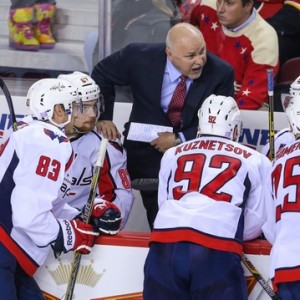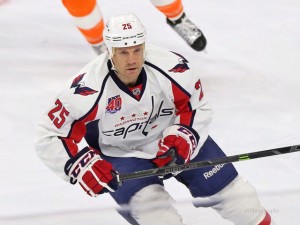
In everyday life we all know that there are three sides to every story – your version, my version and the truth. If you follow pro hockey closely you realize that there are four sides to every game. You have the fans’ perspective, the coach’s take, the players’ viewpoint and the statistical analysis. I’m leaving the media out, since in theory we are the media. The plan throughout the season in this space is to provide you with those four perspectives for games involving the Washington Capitals.
To decipher the coach’s perspective many times you have to wade through a bunch of PR-conscious, “one-game-at-a-time,” monotone comments to determine how the coach really feels. Football coaches seem to be better at this PR game than hockey coaches, but fortunately for us Washington head coach Barry Trotz tends not to sugar coat his thoughts. Hockey players are a little more conservative (aka boring) with their comments, never wanting to throw a teammate under the bus, but they almost always will take accountability when they turn in a stinker. So you usually can figure out their true feelings.
For the hometown fans the considerations are pretty much: Did we win? Was the pace fast and the effort and energy of the home team high? And was there a lot of action (aka goals, spectacular plays, big hits, fights, great saves, etc.). Those aspects of most games aren’t hard to figure out or agree upon.
Then we come to statistics. Back in the day this consisted of goals, shots on goal, saves, penalty minutes, plus/minus, and if we wanted to get crazy, maybe hits, scoring chances and turnovers. In recent years, like other sports, hockey has drifted toward more of a reliance on statistics called analytics. Analytics generally are supposed to provide a more concrete analysis of how or why a team is or isn’t successful by evaluating the individual’s performance as a function of how it contributed to the overall success or failure of the team while that player was in the game.

In hockey most, but not all, of this analysis, is based on puck possession. Some of the analytics include what percentage of time did the team possess the puck while a player was on the ice, how many of his team’s shot attempts was a player on the ice for compared to how many shot attempts were allowed when he was on the ice (Corsi Rating), the same Corsi shots attempted formula without blocked shots being included as attempts because that wouldn’t be considered positive possession (Fenwick), which players did the coach put on the ice for offensive zone vs. defensive zone faceoffs and what were their puck possession analytics (a player who has a high number of defensive zone starts and has a high Corsi would be considered a great two-way player, a la Patrice Bergeron). There are more, but those are some of the basic ones. The variations and formulas are virtually endless.
In this space, however, we will go on a journey together looking at new stats that may or may not turn out to be viable analytics based on the data that is uncovered. We may proceed down one road and it might be obvious that a particular statistic has no real correlation with a team’s overall performance, in which case we will go in a different direction and look at something new. Or we may find some of the numbers we uncover to be interesting and potentially telling in which case we will continue to follow those and maybe tweak them in hopes of uncovering something new. No matter where it all leads, hopefully we will learn something along the way.
While I hardly profess to be the world’s foremost hockey mind, I have been around the game for about 40 years as a player (not a good one), a coach (an okay one) and a sports information director for an NCAA Division I college program. So I’ve seen my fair share of games, and there have always been a few plays or actions that happen consistently and seem to have a positive or negative impact on a team’s overall results.
Some of those consistent in-game events that have made me wonder over the years and that will be examined include:
- The impact of dump-ins on puck possession, shots on goal and scoring opportunities. This includes an overall look at dump-ins and their effect on puck possession as well as comparisons of dump-ins intended to allow players to battle, dump-ins in which the player dumping the puck or a teammate has a direct route to the puck first and safe dump-ins that the opposing team will definitely get to first that are used to negate a delayed offside, facilitate a line change or just kill time late in a game. For simplicity these will be referred to as 50/50 dump-ins, purposeful dump-ins and safe dump-ins, respectively.
- The wrap-around defensive-zone clear. How effective is it and how often does it result in a turnover and subsequently shots on goal and scoring opportunities?
- Grey-zone turnovers: The grey zone is designated as the area within 10 feet on either side of both blue lines. Turnovers in these areas generally are failed clearing attempts (d-zone grey turnovers) or turnovers created when a team tries to carry the puck into the offensive zone instead of dumping it in (o-zone grey turnovers). Grey-zone turnovers on the defensive end often create odd-number situations in favor of the intercepting team, especially when forwards have vacated the zone early. This frequently leads to what has become known as “running around” in the defensive zone. On the other end of the ice grey-zone turnovers often facilitate odd-man rushes going back the other way as the forwards on the team giving up the puck have to throw on the breaks and play catch-up going back the other direction.
Four Corners of the Rink – Washington Capitals Game 1 From Every Angle
Caps 5, Devils 3 – October 10, Verizon Center

The Washington Capitals opened their 2015-16 season Saturday night with an up-and-down 5-3 victory against the New Jersey Devils, getting a goal and an assist from No. 1-star Jason Chimera, a highlight-reel third-period goal and power-play assist from Alex Ovechkin and multiple points from five different players to secure the win.
The Caps jumped to a 2-0 lead in the early going before relaxing a bit and letting the Devils tie the game prior to the end of the first period. New Jersey made the game ugly with a swarming neutral-zone presence through the second period and into the third until Ovechkin opened the floodgates 6:33 into final period. Marcus Johansson and Matt Niskanen later added third-period power-play goals, and Braden Holtby ended up stopping 21 New Jersey shots to pick up the win.
Fans-Eye View
Washington’s season opener had everything a fan could want, although a relatively dull second period put a bit of a damper on things for a while. The arena was packed and the crowd arrived early. There was a red-carpet entrance for all the players in front of Verizon Center, and a goose-bump-inducing pregame pump-up video narrated by Mike Knuble.
The game started with a lot of energy among the players on the ice and the fans in the building, which only increased with two quick Caps goals (including the first for Brooks Orpik in a Washington sweater). Everything calmed down, though, after the Devils responded with a pair tallies to even the score at two after one period. Things remained fairly uneventful until Ovechkin sent the sea of red into a frenzy with his patented between-the-legs dance to the net followed by a top-shelf snipe from in-tight.
The opening-night fans’ report card is as follows:
Final Result: A (A win is a win)
Atmosphere: A (Opening-night energy)
Pace of the Game: B (Second-period, trap-induced lull)
Home Team Effort and Energy: B
Offense: A (5 goals means free Chili’s wings!)
Action: A (Ovechkin’s goal worth the price of admission)
Overall Fan Grade: A
Coach’s Corner

From the tone of his press conference, Caps head coach Barry Trotz wasn’t enamored with the overall effort, but two points is two points. This game really was a case of the more talented team taking over and shutting the door when the game was in the balance.
“I’ll take the result,” Trotz said after the game, “But I didn’t like our first period. We looked like a team that wasn’t playing at game speed, and they were playing at game speed. I didn’t think we deserved to be up 2-0 and then we gave it right back, so I guess it was justice.”
Ovechkin, who didn’t seem to be in midseason physical condition and wasn’t his whirling dervish self most of the night, put the team on his back for about seven minutes in the third period to will Washington to victory. His jaw-dropping goal, very similar to the one against the Devils that earned the NHL Network’s third-best goal of the year last season, was a 170-foot end-to-end rush that culminated with him pulling the puck between his legs to go around John Moore and roofing the puck with a quick finesse shot over goaltender Keith Kincaid’s left shoulder.
“That’s why it’s great to have a guy like Ovie, who didn’t really do much early in the game,” Trotz said. “He really was a non-factor, but when the game was on the line in a 2-2 game he became a factor and he was a big factor in the next two goals.”
Many people think that Ovechkin’s between-the-legs move is him showing off, but if you really break the move down it is a brilliant combination of skill and trickery. Ovechkin gets to a spot near the top of the circle where he is known for shooting his deadly wrist shot then curls the blade of his stick like he’s going to unleash a laser. The defenseman has to respect that possibility and often lunges forward (as Moore did) in an attempt to get his stick in the shooting lane. That’s when Ovechkin pulls the puck back between his legs and explodes past the D-man. At that point he’s too strong and powerful to stop.
Overall Trotz wasn’t thrilled with his team’s performance, which speaks to the talent on this year’s roster since Washington still buried five goals to come away with the victory.
“I didn’t like our overall game,” Trotz said. “We sort of mismanaged it a little bit – too many turnovers. It wasn’t a good game for us, but the power play came up big when we needed it to.”
Why the Long Face, Coach?
Can’t Let Down
There were a few areas Trotz mentioned specifically that need to be tightened up. Something that has haunted the Caps for the past few years has been their tendency to give up a goal immediately after they seize the momentum of a game. Saturday, after Washington had jumped to a 2-0 lead, the fourth line turned in a horrible shift and allowed the Devils to “suck the air right out of the building,” as Trotz put it, with a goal just 22 seconds later.
New Jersey’s goal was the result of an undisciplined forecheck followed by more questionable decision-making by Brooks Laich in his attempt to recover defensively. Initially all three Caps forecheckers set up below the faceoff dots. Laich backtracked a bit to a position higher in the zone, but as the puck went D to D, he took a terrible angle and ended up chasing the puck out of the zone.
Then, when Orpik stepped up at center ice to take the body, Laich continued to follow the puck instead of sprinting back to the defensive zone via the middle of the ice. When the puck squirted free, Laich was stuck near the traffic on the wall and still behind the play. He tried desperately to catch up as the Devils went in on a 2-on-1 against John Carlson, but he never quite made it back into the play, allowing Jiri Tlusty to feather a pass to Adam Henrique for the goal.
Three’s a Crowd
Maybe it was a little bit of a chemistry issue or a case of opening-night over-exuberance, but the Caps absolutely butchered two odd-man rushes in which three players were attacking with possession of the puck. The first was a 3-on-1 for the top line just over a minute into the game and the second was a 3-on-2 for 2/3 of the second line early in the third with the game tied at 2. Both times the three players entered the zone in a straight line across the ice instead of moving into more of a triangular formation, which allowed the defenders to shut down almost all passing options.
In the first scenario, T.J. Oshie carried the puck down the left wing, with Ovechkin in the middle and Evgeny Kuzetsov on the right. All three players were in a straight line across, so the defenseman was able to play the rush like a 2-on-1 and effectively take both off-puck players out of the play. He gave Oshie a wide-open shot and allowed Kincaid to cut down the angle. Oshie tried to force a pass through and it bounced off the D’s stick to Kuznetsov, who had no shooting lane with the defenseman in his way. So he tried to pass back to Oshie and ended up not being able to get it to him in a position to shoot effectively.
The third period 3-on-2 was very similar, with Johansson, Dmitry Orlov and Justin Williams all entering the zone in a straight line across. Johansson passed to Orlov in the center for some reason right before the trio got to the blue line instead of taking the puck wide as is commonly the approach. Orlov dished the puck to Williams on the right side, but all three players kept the same pace, allowing the two defensemen to defend all three of them without having to make a choice. The Caps didn’t get a shot.
In both of these situations, the puck should stay wide in hopes of drawing one defenseman over while one offensive player, usually the guy in the middle, drives hard to the net and the third player delays and heads to the high slot. In the 3-on-2, if the second D-man doesn’t pick up the guy driving the net the puck can be sent toward him in hopes of the redirect. But if the D follows the player to the net, the third player in the high slot is open for a pass and a quality scoring opportunity. In the 3-on-1, one player is always wide open with this approach.
Coach Barry’s Grade for the Caps: C (based on postgame comments)
The Player Perspective
Postgame comments from Caps players indicated a mixed bag of feelings about the team’s season-opening victory:
Brooks Orpik
“We weren’t very good in the first period. Individually I think we can all use a day off to go back and look at a few things. I think we all have a lot of room for improvement.”
Alex Ovechkin on the Overall Game
“The first game you are just excited. You are nervous and want to play more simple. We scored two goals, but I didn’t think we had a good period the first one. Holts after that 5 on 3 when we didn’t score in the second period made a huge save and we end the period tied. We tried to play a simple game in the third, and I think we did a really good job.”
On the Power Play
“Obviously we are still working on it and it’s not perfect yet, but I’m pretty sure we’re going to be fine.”
On the First Line
“Our line didn’t play well the first two periods, but in the third we started moving the puck and got some scoring chances. “
Jason Chimera on the Third Line
“I thought we played really well. They’re pretty easy guys to play with. Beags is one of the hardest-working guys in the NHL. He wins a lot of draws, and we start with the puck a lot. We had a lot of point shots in the first two periods. Get it up top and fire away. When you have three guys working hard down low they have to drop guys down low and we can use the points. It was working well.”
Braden Holtby
“It wasn’t my best game from start to finish, but we grinded it out and got some big goals from veteran guys and that’s what we needed. The PK we like to stick with the same pairs throughout the year, so it will take a little bit to get used your partner and the units. The power play I thought we did a good job, but we miss Nick Backstrom, so you have to re-think how you are doing things. So I thought they did a really good job playing to their strengths.”
Players’ Grade of Themselves: C (based on postgame comments)
Statistically Speaking
We will keep it brief here since it’s hard to determine how meaningful new analytics and stats can be after just one game, but here are some interesting takeaways:
- New Jersey is known to be more of a simple, up-and-down team, while the Caps traditionally are more creative. The dump-in stats certainly indicated that still is the case. Overall the Devils dumped the puck 27 times, coming way with possession on 14 occasions (51.9%). The Caps, on the other hand, dumped it 21 times, gaining possession on seven occasions (33.3%).
- The Devils recorded only four shots on goal of their 24 total shots when they dumped the puck and retained possession (16.7%). Washington recorded three of its 27 shots after dump-ins (11.1%).
- Wrap-around clears were not prevalent, but were generally successful, with the Caps going 3-for-4 and the Devils going 2-for-3.
- Looking at the grey-zone situation, Washington lost possession seven times trying to enter the offensive zone with New Jersey losing possession six times. Leaving the defensive zone, however, the Caps gave it up 11 times compared to the Devils’ 13.
- Overall, none of the offensive grey-zone giveaways resulted in odd-man rushes, while one of the d-zone giveaways did.
- Of those 11 grey-zone defensive giveaways, Washington surrendered shots on goal five times (45.5%) and gave up 10 total shots on goal (42% of total shots on goal allowed), six scoring chances and one goal.
- New Jersey allowed four total shots on goal (16.7 percent of total shots on goal allowed) on its 13 grey-zone turnovers, including one scoring chance and one goal.